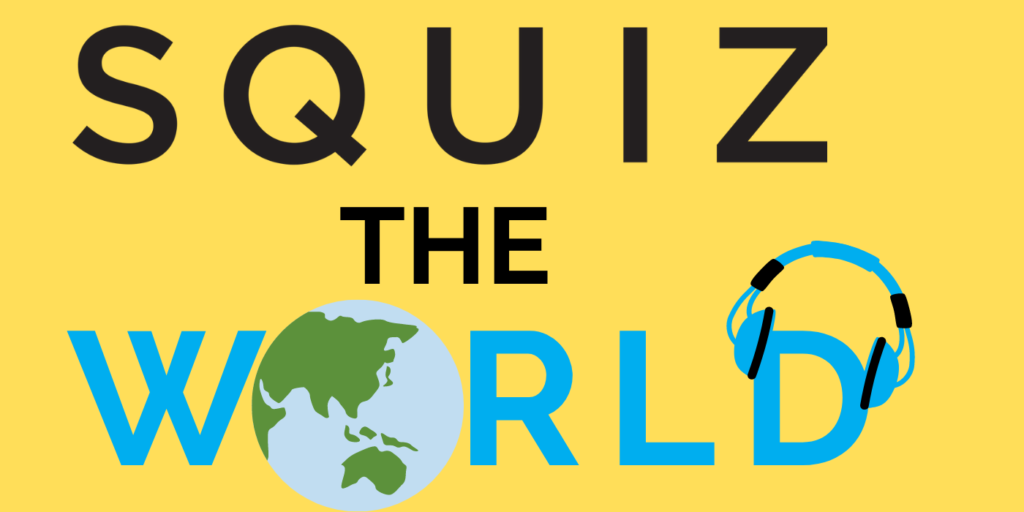
Squiz the World goes to… Argentina
LINKS:
The Casa Rosada, or Pink House: https://turismo.buenosaires.gob.ar/en/atractivo/casa-rosada
Pato, known in English as “horseball”: https://video.link/w/W6rsd
Steak with chimichurri sauce: https://www.bbcgoodfood.com/recipes/steak-chimichurri-sauce
Black bean chimichurri salad: https://www.bbcgoodfood.com/recipes/black-bean-chimichurri-salad
EPISODE TRANSCRIPT
Each week, we give the world globe a spin, and see where we land. Then we take the kids of Australia on an audio excursion to visit that country and its people.
I’m Amanda Bower, and today on Squiz the World we’re visiting a country that gave the world the tango… soccer superstar Lionel Messi calls it home … and it where would be quite challenging to be a vegetarian. Strap yourselves into the Squiz Kids Super Fast Supersonic Jetliner as we take off and take a squiz at Argentina …
Just the Facts
Argentina is on the east coast of South America, and is famous for having both the highest and lowest points in the Southern hemisphere!
Another geographical feature of Argentina is that the city of Ushaia is the closest city in the world to Antarctica. In 1977, the Argentinian government actually sent a pregnant woman to Antarctica to give birth there, to try to help them claim part of the icy continent!
Baby Emilio Marcos Palma is recognised by the Guinness Book of Records as the first known person to be born on the Antarctic continent, but the rest of the world has not recognised “Argentine Antarctica.” So that chilly birthday backfired.
Speaking of politics, Argentina is now a democracy, but it had a complicated 20th century. The military overthrew the government six times in the middle of last century. The 21st century also didn’t start particularly well … starting in December 2001, Argentina had five presidents in just two weeks!
Its economy was in a terrible depression—half the country was considered to be living in poverty—and after huge protests and riots, the President resigned and fled the capital, Buenos Aires by helicopter. Over the next two weeks, three other people were temporarily president until a new president managed to stick it out in the Pink House for a whole year. Argentina continues to have a high poverty rate, although the economy has improved, and democracy has stabilised.
What? Oh, you want to know more about the pink house I mentioned? You know how in America, the president lives in the White House? Well in Argentina, the president works in a building that officially has a very boring name, but it’s pink… so the locals call it the Casa Rosada, or Pink House. If you’ve ever heard of the movie Evita, or the song Don’t Cry for me, Argentina… it was from the balcony of the Casa Rosada where, in the 1950s, the Argentinian president’s and his wife, Eva Perón, addressed their masses of supporters. I’ll put a link in your episode notes to the Pink House.
Whenever you travel, it’s important to learn a few words in that country’s language. It’s a great way to show respect. So, let’s….
Learn the Lingo
Argentina is the largest Spanish speaking country in the world… and we’ve got Squiz Kid Ignacio, who lives in Sydney and has an Argentinian Dad, to teach us a typical Argentinian greeting..
Hola! Que tal, che?
What he’s saying there is the Argentinian version of Hello! Hey, how’s it going? The word ‘che’ is a kind of filler word that means something similar to “hey”… which may surprise those of you who are familiar with Che Guevara, the Argentinian political revolutionary. His real name was Ernesto Guevara, but he said “che” so much when he talked, it became his nickname.
So if you want to sound like a local in Argentina, you’ll want to sprinkle “”che”” around. Give it a try… Hola! Que tal, che?
People are always really grateful when you just try to speak their language. They may even thank you for it. We learned how to say thank you when we went to Costa Rica… who can remember? Gracias! So, Gracias to you, Ignacio…
Now that we can communicate a little bit, it’s….
Time for School
In Argentina, the school year begins March, and ends in the middle of December. Middle of December all the way to March? That’s a LONG summer holiday. But Argentinian kids actually go to school for more days each year than we do in Australia… they just have fewer holidays during the school year. What would you prefer? A super long summer holiday and two terms, or holidays spaced out over four terms?
The other big difference is that most kids only go to school for four hours a day – there are two sessions of school, like we learned there is in Brazil, and you’re either a morning or afternoon student. Many experts say that it’s hard to teach kids everything they need to know in just four hours, so full-day schools are becoming more common.
One of the reasons for that is that studies have found that only about one quarter of kids who start uni in Argentina actually finish. The drop-out rate is one of the highest in the world. So… maybe it is a good idea to spend more time learning in primary and high school, so you can stick it out at uni.
Okay, enough academics. I reckon it’s…
Sport Time
Anyone who loves soccer has heard of Lionel Messi… he’s probably the most famous Argentinian in the world. Actually, Pope Francis is also from Argentina… it may be a tie!
Even though Leo moved from Argentina to Barcelona when he was just 13, he’s still a proud Argentinian… he is the captain of the national team, the country’s leading goal scorer of all time, and he donates a lot of money to support youth football in Argentina.
In fact, Leo is such a legend in his hometown of Rosario, that the local government there passed a law prohibiting people from calling their children “Messi”! Plenty of people call their kid Lionel, of course, but that isn’t as obvious a tribute as Messi…
Now despite all the love for soccer, it is actually NOT the national sport of Argentina. That honour was given in 1953 to a sport called “Pato”. It’s a bit like basketball on horseback… with a net at either end of the field that looks a bit like a Quidditch goal. Back in the old days, players used to throw a basket at the goal… and that basket had … a live duck inside…
Pato means duck in Spanish. That version of the game has been banned – as you can imagine, the ducks HATED it. It’s now played with a ball that has six handles – I’ll put a link to a video in your episode notes, it’s fun to watch.
Goodness, all that sport has made me starving! Although I definitely don’t want to eat duck. I think it might be…
Dinner Time
I’ve got one word for you. Beef.
Argentinians eat about 50kg of beef per person, per year… whereas Australians, who eat a LOT of meat, eat just under 20kg of beef. And back in the 1950s, the average Argentinian ate 100kg of beef per year! That’s a lot of visits to the parilla, or steakhouse…
So yes, the national dish of Argentina is an asado, or variety of barbecued meat. I’ve popped a link in your episode notes to a recipe for chimichurri sauce, which is a fresh green sauce that’s served on top of just about everything… and, for those of you who don’t eat meat, I’ve also popped in a recipe for black bean chimichurri salad. And if you want to be a true Argentinian, you won’t eat dinner until about 10pm… even the kids!
The S’Quiz
This is the part of the podcast where you get to test how well you’ve been listening.
Question 1. America has the white house, Argentina has the…
Question 2. What does the word “pato” mean? Hint… it’s related to sport.
Question 3. Citizens of the town of Rosario are banned from calling their babies what?
